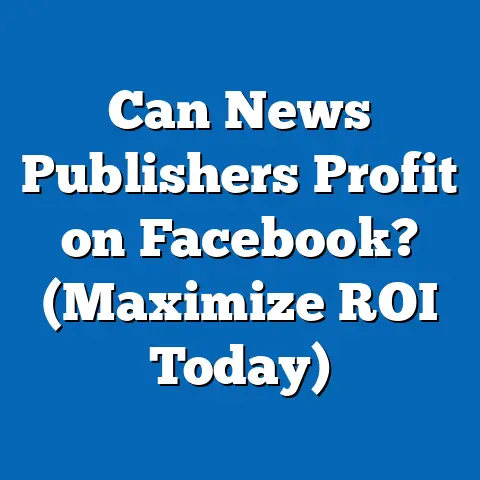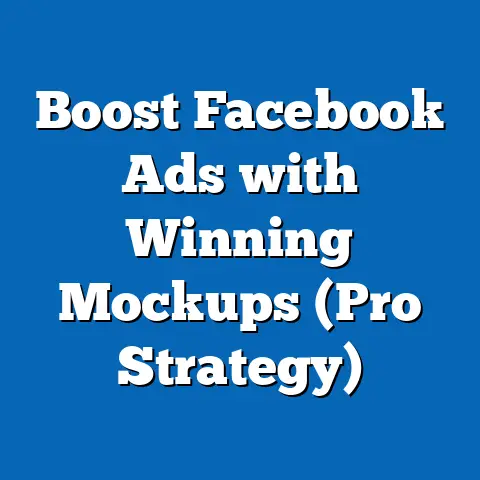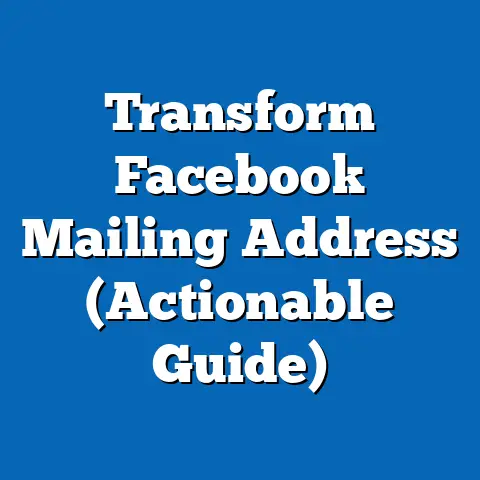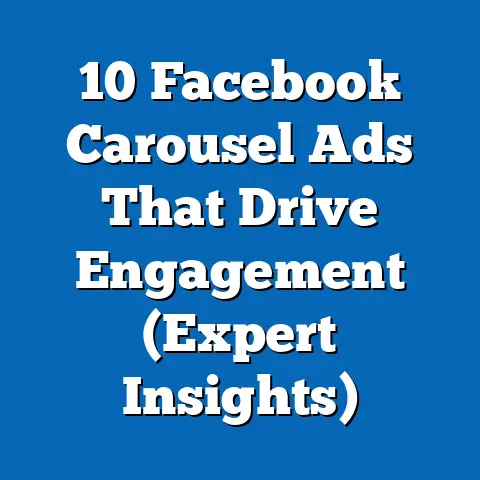Transform Image Sizes for Facebook Carousel Ads (Pro Tips)
I’ve always found a strange satisfaction in decluttering. There’s something incredibly satisfying about taking a messy, chaotic space and transforming it into a clean, organized haven. It’s like a breath of fresh air for the mind, creating a sense of calm and focus. And, believe it or not, I see a direct parallel between this process and the often-overlooked importance of visual clarity in Facebook carousel ads.
Think about it: just as a cluttered environment can distract and overwhelm, poorly sized or optimized images in your ads can hinder your message, confuse your audience, and ultimately, hurt your campaign performance. On the other hand, well-sized and visually appealing images can grab attention, engage potential customers, and drive conversions.
Understanding Facebook Carousel Ads
Let’s start with the basics. What exactly are Facebook carousel ads?
Carousel ads are a dynamic ad format that allows you to showcase multiple images or videos (up to 10!) within a single ad unit. Users can swipe through the carousel to view each card, providing a more engaging and interactive experience compared to traditional static image ads.
Each card in the carousel can feature its own headline, description, link, and call-to-action (CTA), making it a versatile format for:
- Showcasing multiple products: Highlight different features or benefits of each product.
- Telling a story: Create a narrative across the carousel cards to engage users.
- Highlighting different aspects of a single product: Show different angles, use cases, or customer testimonials.
- Driving traffic to multiple landing pages: Direct users to specific product pages or relevant content.
The Benefits of Carousel Ads
I’ve personally seen firsthand how effective carousel ads can be. They offer several key advantages over static image ads:
- Increased Engagement: The interactive nature of carousel ads encourages users to swipe and explore, leading to higher engagement rates (likes, comments, shares).
- Enhanced Storytelling: Carousel ads allow you to tell a more complete story about your brand, products, or services.
- Improved Product Showcase: You can showcase multiple products or features within a single ad, increasing the chances of capturing a user’s interest.
- Higher Click-Through Rates (CTR): By providing more information and multiple calls-to-action, carousel ads often achieve higher CTRs compared to static ads.
- Better Conversion Rates: With more engaging visuals and targeted messaging, carousel ads can lead to improved conversion rates.
According to Facebook, carousel ads can drive 10x more traffic to advertisers’ websites compared to static social media ads. In one of my campaigns, I saw a 40% increase in click-through rates when I switched from a single image ad to a carousel ad showcasing multiple product variations.
Takeaway: Facebook carousel ads are a powerful and versatile ad format that can significantly improve engagement, storytelling, product showcase, and overall campaign performance.
The Importance of Image Size in Carousel Ads
Now, let’s talk about why image size matters so much in the world of carousel ads. It’s not just about making your images look pretty (although that’s important too!). The right image size can directly impact the loading time, viewability, and overall performance of your ads.
How Image Size Affects Ad Performance
- Loading Time: Large image files can significantly slow down the loading time of your ads, especially for users with slow internet connections or on mobile devices. This can lead to frustration and a higher bounce rate, as users are less likely to wait for your ad to load.
- Viewability: If your images are not properly sized, they may appear distorted, pixelated, or cropped, making them less visually appealing and harder to understand. This can reduce the overall impact of your ad and make it less likely to capture a user’s attention.
- Overall Performance: Ultimately, the right image size can affect the overall performance of your carousel ads, including engagement rates, click-through rates, conversion rates, and cost per acquisition (CPA).
Common Pitfalls of Using the Wrong Image Size
I’ve seen it happen countless times: businesses invest time and money into creating beautiful carousel ads, only to have them fall flat because of incorrect image sizing. Here are some common pitfalls to avoid:
- Distortion: Stretching or compressing images to fit the carousel format can lead to distortion, making your products look unnatural and unappealing.
- Pixelation: Using low-resolution images can result in pixelation, making your ads look unprofessional and low-quality.
- Loss of Message Clarity: Cropping images incorrectly can cut off important details or text, making it harder for users to understand your message.
The Concept of Aspect Ratio
Before we dive into the recommended image sizes, let’s quickly touch on the concept of aspect ratio. Aspect ratio refers to the proportional relationship between the width and height of an image. It’s typically expressed as two numbers separated by a colon, such as 1:1 (square) or 16:9 (widescreen).
Maintaining the correct aspect ratio is crucial for ensuring that your images appear correctly in the carousel format. If you use an image with the wrong aspect ratio, Facebook may automatically crop or resize it, leading to distortion or loss of important content.
Takeaway: Image size plays a critical role in the performance of your Facebook carousel ads. Using the wrong image size can lead to slow loading times, poor viewability, and reduced engagement. Always pay attention to the recommended image sizes and aspect ratios to ensure that your ads look their best.
While Facebook’s specific recommendations may change slightly over time, here are the general guidelines to follow for optimal results:
- Recommended Pixel Dimensions: 1080 x 1080 pixels (square)
- Aspect Ratio: 1:1 (square)
- File Size: Under 30MB
Why These Dimensions?
- Square Format: The square 1:1 aspect ratio is generally recommended for carousel ads because it looks good on both desktop and mobile devices.
- 1080 x 1080 Pixels: This resolution provides a good balance between image quality and file size. It’s high enough to ensure that your images look sharp and clear, but not so high that they take too long to load.
- Under 30MB: Keeping your file size under 30MB helps to ensure that your ads load quickly, even on slower internet connections.
Facebook Image Compression
It’s also important to understand how Facebook compresses images. When you upload an image to Facebook, the platform automatically optimizes it for web viewing, which often involves reducing the file size and quality.
This means that even if you upload a high-resolution image, Facebook may compress it to a lower resolution to save bandwidth and improve loading times. Therefore, it’s essential to start with a high-quality image and optimize it yourself before uploading it to Facebook.
Here are a few tips for minimizing the impact of Facebook’s image compression:
- Use JPEG or PNG format: These formats are generally well-suited for web images and offer a good balance between quality and file size.
- Optimize your images before uploading: Use image editing software to reduce the file size and optimize the resolution of your images before uploading them to Facebook.
- Avoid using too much text in your images: Text can often appear blurry or distorted after compression, so try to keep the amount of text in your images to a minimum.
Takeaway: The recommended image size for Facebook carousel ads is 1080 x 1080 pixels with a 1:1 aspect ratio and a file size under 30MB. Understanding how Facebook compresses images is also crucial for ensuring that your ads look their best.
Tools and Techniques for Sizing Images
Now that you know the ideal image sizes for Facebook carousel ads, let’s talk about the tools and techniques you can use to resize your images. Fortunately, there are plenty of options available, ranging from simple online tools to powerful graphic design software.
Online Image Resizers
For quick and easy resizing, online image resizers are a great option. These tools allow you to upload an image, specify the desired dimensions, and download the resized image in a matter of seconds. Some popular online image resizers include:
- Canva: While Canva is primarily a graphic design tool, it also offers a simple and effective image resizing feature.
- PicResize: PicResize is a dedicated image resizing tool that offers a variety of options, including cropping, resizing, and optimizing images for web viewing.
- iLoveIMG: iLoveIMG is another popular online image resizing tool that offers a user-friendly interface and a range of features.
How to Resize Images Using Canva (Example):
- Go to Canva’s website and create a free account (if you don’t already have one).
- Click on “Create a design” and select “Custom size.”
- Enter the desired dimensions (e.g., 1080 x 1080 pixels) and click “Create new design.”
- Upload your image to Canva.
- Drag and drop your image onto the canvas.
- Resize and reposition your image as needed.
- Click on “Share” and select “Download.”
- Choose the desired file format (e.g., JPEG or PNG) and click “Download.”
Graphic Design Software
For more advanced image editing and resizing, graphic design software like Adobe Photoshop or GIMP (a free, open-source alternative) is a great option. These tools offer a wider range of features and allow you to fine-tune your images to perfection.
How to Resize Images Using Adobe Photoshop (Example):
- Open your image in Photoshop.
- Go to “Image” > “Image Size.”
- Enter the desired dimensions (e.g., 1080 x 1080 pixels).
- Make sure the “Resample” option is checked and choose a resampling method (e.g., “Bicubic Smoother” for enlargement or “Bicubic Sharper” for reduction).
- Click “OK.”
- Go to “File” > “Save As” and choose the desired file format (e.g., JPEG or PNG).
- Adjust the image quality settings as needed and click “Save.”
Social Media Management Tools
Some social media management tools, such as Buffer and Hootsuite, also offer built-in image resizing features. These tools can be particularly useful if you’re already using them to manage your social media accounts.
Takeaway: There are many different tools and techniques you can use to resize your images for Facebook carousel ads. Choose the option that best suits your needs and skill level.
Pro Tips for Optimizing Images for Carousel Ads
Resizing your images is just the first step. To truly make your carousel ads stand out, you need to optimize your images for maximum impact. Here are some pro tips to keep in mind:
- Use High-Resolution Images: Always start with high-resolution images to ensure that your ads look sharp and clear, even after compression.
- Maintain a Consistent Aesthetic: Use a consistent color palette, font, and overall style across all images in your carousel to create a cohesive and professional look.
- Optimize for Mobile Viewing: Keep in mind that a significant portion of Facebook users access the platform via mobile devices, so make sure your images look good on smaller screens.
- Use Engaging Visuals: Choose images that are visually appealing, relevant to your target audience, and that effectively communicate your message.
- Add Text Overlays: Consider adding text overlays to your images to highlight key information or calls-to-action. Just make sure the text is easy to read and doesn’t distract from the overall image.
Engaging Visuals that Resonate
The key to creating truly effective carousel ads lies in using visuals that resonate with your target audience. Think about what motivates them, what their pain points are, and what kind of imagery they’re most likely to respond to.
- Colors: Use colors that are consistent with your brand and that evoke the desired emotions.
- Branding Elements: Incorporate your logo, brand colors, and other branding elements to create a recognizable and memorable ad.
- Text Overlays: Use text overlays strategically to highlight key benefits, features, or calls-to-action.
I once worked with a client who was struggling to get traction with their carousel ads. We analyzed their target audience and discovered that they were highly motivated by social proof and testimonials. We then redesigned their carousel ads to feature customer testimonials prominently, along with engaging visuals of their products in action. The results were dramatic: their click-through rates increased by 75%, and their conversion rates doubled.
Takeaway: Optimizing your images for Facebook carousel ads goes beyond just resizing. Use high-resolution images, maintain a consistent aesthetic, optimize for mobile viewing, and use engaging visuals that resonate with your target audience.
A/B Testing Your Carousel Ads
No matter how much research you do or how many best practices you follow, the only way to truly know what works best for your audience is to A/B test your carousel ads.
What is A/B Testing?
A/B testing (also known as split testing) is a method of comparing two versions of an ad to see which one performs better. In the context of carousel ads, you could A/B test different image sizes, formats, or even the overall visual style.
Why is A/B Testing Important?
A/B testing allows you to:
- Identify the most effective image sizes and formats for your audience.
- Optimize your carousel ads for maximum engagement and conversions.
- Reduce your advertising costs by focusing on the ads that perform best.
How to Set Up A/B Tests for Image Sizes
- Create two versions of your carousel ad, each with a different image size or format. For example, you could test a 1080 x 1080 pixel square image against a 1200 x 628 pixel landscape image.
- Set up your A/B test in Facebook Ads Manager. You can use the “Split Test” feature to automatically divide your audience between the two versions of your ad.
- Run your A/B test for a sufficient period of time (at least a few days) to gather enough data.
- Analyze the results and identify the winning version of your ad.
- Implement the winning image size or format in your ongoing carousel ad campaigns.
Metrics to Analyze
When analyzing the results of your A/B tests, pay attention to the following metrics:
- Click-Through Rate (CTR): The percentage of people who saw your ad and clicked on it.
- Conversion Rate: The percentage of people who clicked on your ad and completed a desired action (e.g., made a purchase, signed up for a newsletter).
- Cost Per Click (CPC): The average cost you pay each time someone clicks on your ad.
- Cost Per Acquisition (CPA): The average cost you pay each time someone completes a desired action.
Takeaway: A/B testing is a crucial part of optimizing your Facebook carousel ads. Use A/B testing to identify the most effective image sizes and formats for your audience and to continuously improve your campaign performance.
Remember, the key to success with Facebook carousel ads lies in paying attention to the details. By using the correct image sizes, optimizing your visuals for maximum impact, and continuously A/B testing your ads, you can significantly improve your engagement rates, click-through rates, and conversion rates.
So, what are you waiting for? Start experimenting with your carousel ads today and see the difference that well-sized and optimized images can make!
Call to Action
I’d love to hear about your experiences with Facebook carousel ads. What image sizes and formats have worked best for you? What challenges have you faced? Share your thoughts and questions in the comments section below! Let’s learn from each other and create even more effective Facebook ad campaigns.






